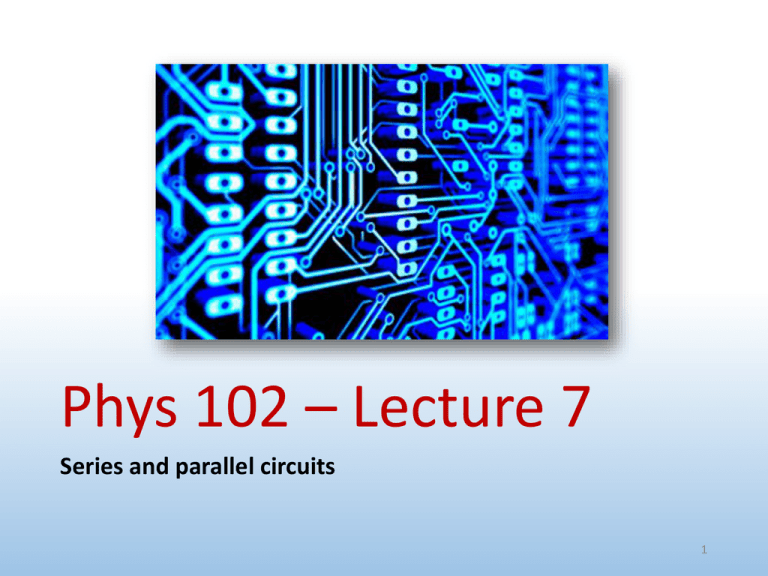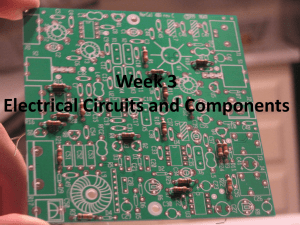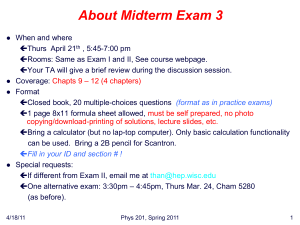ppt
advertisement

Phys 102 – Lecture 7 Series and parallel circuits 1 Recall from last time... Electric potential difference across circuit element is its “voltage” Velement Should be “ΔV”, but we’ll usually drop the “Δ” + ε Batteries – pump charges Provide emf for charges Vbattery R Resistors – regulate current Dissipate power VR IR C Capacitors – store charge Store energy VC Q C Wires are ideal conductors, with no resistance. E = 0, the electric potential is constant and the voltage across a wire is 0. Phys. 102, Lecture 7, Slide 2 Today we will... • Learn about electric circuits Circuits with a battery, wires, and resistors Circuits with a battery, wires, and capacitors • Analyze circuits Take a complex-looking circuit like... ...and turn into a simple-looking circuit like + + Phys. 102, Lecture 7, Slide 3 Electric circuits Electric circuits consist of one or more closed loops around which charges flow Closed Open circuit circuit + + + + + + + + I Phys. 102, Lecture 7, Slide 4 Kirchhoff loop rule A charge making a complete loop around a circuit must return to the same electric potential (“height”) at which it started + ε R Sum of electric potential differences (voltages) around circuit loop is zero VR + ε Resistor R (bumpy hill) Battery (pump) V 0 Phys. 102, Lecture 7, Slide 5 Series components Two components are said to be in series when they are connected end-to-end by a single wire I1 ε + I2 R2 R1 V1 R1 ε V2 R2 Phys. 102, Lecture 7, Slide 6 ACT: CheckPoint 1.2 Consider a circuit with two resistors R1 and R2 in series. Compare the voltages across the resistors: ε + R1 = 1 Ω R2 = 10 Ω A. V1 > V2 B. V1 = V2 C. V1 < V2 ACT: Capacitors in series Consider a circuit with two capacitors C1 and C2 in series. Compare the + voltages across the capacitors: ε C1 = 1 μF C2 = 10 μF A. V1 > V2 B. V1 = V2 C. V1 < V2 Phys. 102, Lecture 7, Slide 8 Equivalent resistance & capacitance Circuit behaves the same as if series components were replaced by a single, equivalent component Resistors R1 V1 I1 R2 I2 Req = V2 I1 I 2 Ieq Veq V1 V2 Veq Req R1 R2 Ieq Capacitors C2 C1 Q1 –Q1 V1 Q2 –Q2 Ceq = V2 Qeq Q1 Q2 Qeq –Qeq Veq Veq V1 V2 1 1 1 Ceq C1 C2 Phys. 102, Lecture 7, Slide 9 Calculation: vascular resistance The circulatory system is analogous to an electric circuit Pressure difference Blood flow Vascular resistance emf Electric current Electrical resistance The circulatory system consists of different types of vessels in series with different resistances to flow εheart = 120 V* Vein Venule Capillary Arteriole Artery RV = 4 Ω Rv = 6 Ω Rc = 20 Ω Ra= 50 Ω RA = 20 Ω *Numbers represent accurate relative values Phys. 102, Lecture 7, Slide 10 Calculation: vascular resistance Calculate the current I through the vascular circuit and the voltages across the different types of vessels εheart = 120 V εheart Simplify Vein Venule Capillary Arteriole Artery RV = 4 Ω Rv = 6 Ω Rc = 20 Ω Ra = 50 Ω RA = 20 Ω Expand Req Phys. 102, Lecture 7, Slide 11 Kirchhoff junction rule Charges flowing through a junction split. By conservation of charge, the sum of currents into a junction equals the sum of currents out of a junction I2 I2 I1 + + + + + + + I3 – Junction I1 I3 Iin Iout Phys. 102, Lecture 7, Slide 12 Parallel components Components are said to be in parallel when both ends are connected to each other, forming a loop containing only them I I2 I1 ε + R1 I I1 I2 V2 R2 ε V1 Phys. 102, Lecture 7, Slide 13 ACT: Parallel or series? Consider the circuit to the right. Which of the following statements is true? C2 ε + C1 C4 C3 A. C1 & C4 are in series B. C2 & C4 are in parallel C. C1 & C3 are in parallel Phys. 102, Lecture 7, Slide 14 ACT: Resistors in parallel Consider a circuit with two resistors R1 and R2 in parallel. Compare I1, the current through R1, to I2, the current through R2: + ε R1 = 1 Ω R2 = 10 Ω A. I1 > I2 B. I1 = I2 C. I1 < I2 Phys. 102, Lecture 7, Slide 15 ACT: CheckPoint 2.3 Now we add a switch S. What happens to the current out of the + battery when the switch is closed? S ε R1 R2 A. Ibattery increases B. Ibattery remains the same C. Ibattery decreases DEMO Phys. 102, Lecture 7, Slide 16 Equivalent resistance & capacitance Circuit behaves the same as if parallel components were replaced by a single, equivalent component V1 R1 Resistors V1 C1 I1 Req R2 I2 = Veq V2 I1 I 2 Ieq V1 V2 Veq 1 1 1 Req R1 R2 Capacitors Q1 –Q1 Ieq C2 Ceq = Qeq –Qeq Q2 –Q2 Veq V2 Q1 Q2 Qeq V1 V2 Veq Ceq C1 C2 Phys. 102, Lecture 7, Slide 17 Calculation: vascular resistance In previous calculation, capillaric resistance accounts for ~20% of total vascular resistance, yet capillaries are the thinnest blood vessels, and should have the highest resistance. Why? Vein Artery Venule Arteriole Capillary Phys. 102, Lecture 7, Slide 18 Calculation: cardiovascular system The human cardiovascular system consists of two circuits: pulmonary circulation which carries blood though the lungs, and systemic circulation which carries blood to the organs The organs of the body are connected in parallel in the systemic circuit Simple circuit model*: Rpulm = 12 Ω, Rbrain = 1 kΩ, Rbody = 160 Ω, εheart = 120 V *Numbers represent accurate relative values Calculate current through each component of circulatory system Rbrain Rpulm εheart + Rbody Phys. 102, Lecture 7, Slide 19 ACT: analyzing circuits Which of the following circuit is different than the others? I II III + + + A. B. C. D. E. Circuit I Circuit II Circuit III All three are equivalent All three are different Phys. 102, Lecture 7, Slide 20 Calculation: circulatory system Calculate current through each component of circulatory system Rpulm = 12 Ω, Rbrain = 1 kΩ, Rbody = 160 Ω, εheart = 120 V Rpulm Rpulm Simplify + εheart Rbody Rbrain Rbrain & Rbody are in parallel 1 Rsyst 1 Rbrain 1 Rbody Simplify + εheart + Rsyst εheart Rpulm & Rsyst are in series Rtot Rpulm Rsyst Vsyst Vbrain Vbody Vtot Vpulm Vsyst εheart Isyst Ibrain Ibody Iheart Ipulm Isyst Phys. 102, Lecture 7, Slide 21 Rtot Calculation: circulatory system Calculate current through each component of circulatory system Rpulm = 12 Ω, Rbrain = 1 kΩ, Rbody = 160 Ω, εheart = 120 V Rpulm Expand + εheart Rtot + εheart Rsyst Rpulm & Rsyst are in series Rtot Rpulm Rsyst Vtot Vpulm Vsyst εheart Ipulm Isyst Iheart Phys. 102, Lecture 7, Slide 22 Calculation: circulatory system Calculate current through each component of circulatory system Rpulm = 12 Ω, Rbrain = 1 kΩ, Rbody = 160 Ω, εheart = 120 V Rpulm Expand + εheart Expand + εheart Rtot Rpulm Rsyst + εheart Rbody Rbrain & Rbody are in parallel 1 Rsyst 1 Rbrain 1 Rbody Vsyst Vbrain Vbody Isyst Ibrain Ibody Phys. 102, Lecture 7, Slide 23 Rbrain Summary of today’s lecture • Two basic principles: • Kirchhoff loop rule Voltages around circuit loop sum to zero (based on conservation of energy) V 0 • Kirchhoff junction rule Currents into a circuit branch equal currents out (based on conservation of charge) Iin Iout Phys. 102, Lecture 7, Slide 24 Summary of today’s lecture • Series components Currents are the same Ieq I1 I 2 Voltages add Veq V1 V2 1 1 1 Resistors Req R1 R2 Capacitors Ceq C1 C2 • Parallel components Voltages are the same Veq V1 V2 Currents add Ieq I1 I2 Resistors 1 1 1 Capacitors Ceq C1 C2 Req R1 R2 • Don’t mix equations! Phys. 102, Lecture 7, Slide 25








